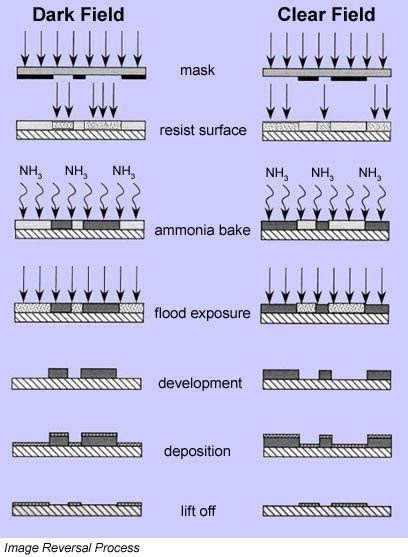This process reverses the action of positive resist so negative images can be formed with the same resolution and processing ease that a positive resist allows. What’s more, image reversal allows variations of the slope of the photoresist sidewall for higher resolution and/or lift off profiles.
For example, if the normal slope of approximately 68 degrees is altered to 90 degrees vertical, resolution is increased 20%. And, if an angle of 112 degrees is achieved, there is a strong overhang that makes metal deposition followed by liftoff controllable.
Image reversal advantages:
- Allows variations of the slope of the photoresist sidewall for higher resolution and improved lift off. Replaces use of harsh chemicals or plasma “metal etch” processes.
- Using image reversal on two or more layer resist levels can eliminate residual photoresist along the sidewalls, preventing “shorts” from level to level without reducing line width.
- Image reversal done with dark or light fields eliminates standing waves; this allows steep and straight profiles, repeatable results, and excellent chemical deposition uniformity.
- Image reversal achieves excellent results for rework problems; underlying substrate is protected (for a double metal process), so unwanted metal can be stripped away without pitting or eroding the underlying level.
Why not just use a negative resist?
Positive resist offers far better resolution, and it doesn’t require solvents for development. In contrast, the resolution limit of negative resist is approximately 1 micron, and it requires solvents known to be carcinogens.
YES image reversal systems deliver anhydrous ammonia (NH3) into a vacuum oven. There are two advantages of an ammonia system: 1) easier control of vapor pressure, and 2) an absence of residual water vapor, which will react with the NH3 to produce NH3OH, a corrosive to the system that also creates contaminating particles.
For more information on achieving repeatable and usable reversals, visit the YES-58TA & 310TA product pages.


